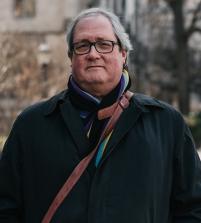
Masks
The social effects of wearing a moral choice on our face
As the default setting for discussions of COVID has shifted to percentages of inoculation, the question of masks and masking has become a secondary, albeit to some still pressing, consideration. I have found myself nothing less than obsessed with masks and masking throughout the pandemic, not least because the use of masks has proven to be at once decidedly consequential and alarmingly discretionary: something everyone should do that not everyone has been doing. It’s also true that, unlike a shot in the arm, wearing a mask makes a visible social statement of awareness and concern for self and others.
My guess is that even once we have achieved a meaningful level of vaccinations, masks will remain an ongoing consideration for many of us, at least in lines at stores and in crowded spaces on subways and the like. Ditto our cumulative experience of their presence and the signals they send. Masks will continue to afford a significant index of how we respond in the midst of COVID even as we vaccinate.
My first COVID mask was a repurposed bra, mailed from an enterprising woman in Germany. She was responding to the reported crisis of PPE materials and charged $5.00. It was black and arrived with handwritten instructions explaining that it had been sewn so that the thin metal reinforcement would adapt to the bridge of my nose and relieve pressure from the ear loops. It worked beautifully and I wore it everywhere and with continual gratitude for six months. I am not fully clear why, but none of the masks I’ve worn since have been nearly so comfortable or nearly so reassuring to me.
That mask remains, much more starkly than the vaccinations, a metonym of the surreality of my pandemic year: its odd admixture of strangeness, plausibility, and sheer luck was at once defining, and beyond planning and expectation.
Having found my own lucky mask, over the ensuing months I would observe who was and who wasn’t wearing a mask, and speculate about why they were or weren’t. I would return from my daily exercise and announce to my spouse first not the length or the pace of my walk but my “count:” how many people I encountered were, and how many were not, masked. I register with some embarrassment the urgency and compulsion of this. But I didn’t cease and desist. It was prompted by a mixture of fear and righteousness: fear that I might be endangered by the unmasked, and righteousness because I was following the best practices when others were not. I found affirmation in the many people who were wearing masks. I was enraged by the approximately equal number who did not.
It seemed to me then, and still does, that only some people truly recognized, or were able to act upon, the fact that we faced an international health crisis.
My observations of others did not hew to my own stereotypes. Most striking in this regard was the day last summer that involved two very different encounters on the Midway Plaisance here in Chicago. As I proceeded east on 60th Street, I could see a group of four loud and boisterously jolly teenagers approaching from the opposite direction. As we got closer, I could see to my surprise and relief that they were masked and six feet apart. They were unaware of me, and I moved into the street to maintain social distance just as I heard one say to the other three: “Did you see that [expletive deleted] old man on 62nd Street? Coughing and no mask! I said, ‘Sir! You need to get inside immediately.’” Uproarious, approbative laughter erupted among the quartet—and then abruptly ceased when they sighted me. Wanting to break the silence and their worry, I waved and said, “Hey, I’m glad you told him to get inside.” More laughter, this time of relief, waves all around, and we proceeded on our opposite ways.
Several blocks further down the street, I encountered an elderly couple slowly walking arm-in-arm, (defiantly?) unmasked. Again, I moved into the street; unlike the previous encounter, however, they studiously avoided eye contact. I chose to say nothing to them.
I may risk overstating the extent to which the experience of COVID is encapsulated by the wearing or non-wearing of masks. But I think that their use and non-use—and my particular obsession with that divergent, unpredictable reality—signal tangible lessons. Some are personal and probably idiosyncratic. I am more observant and more judgmental of the behavior of others than I acknowledge. I have been pleased and reassured when people whom I assume will be unthinking prove me wrong. And, correspondingly, I have been bewildered and felt betrayed when people whom I assume will know better act in ways that I regard as thoughtless—both for themselves and, yes, for me.
Some of the lessons are social. Masks have not just medical but cultural functions, and to control the spread of a virus by wearing a mask is to generify human beings—arguably reflexive actions, orders from the state as it were, that ought to worry us more than they do. While I disagree entirely, I probably should be able to grasp, at least a bit better than has been the case, the level of resistance to masking—recognizing that to understand is a matter of civility rather than endorsement.
Most acutely, I have had to acknowledge that our divergent behavior about masking signals our inability to achieve consensus about nothing less than matters of life and death. This itself is distressing. That it is not only possible but utterly plausible to sort these decisions with reference to politics is an unnerving argument against my own cherished impulse to a bipartisan political disposition.
If the pandemic has brought into relief a number of truths about our world that we have chosen to ignore, I suspect that the use and the disregard of masks will prove central to whatever grasp we will come to have. No small irony of the pandemic is that what we learn about ourselves and about each other will pivot on our individual and collective decisions about whether to hide, or not to hide, our faces from public view.
Photo via Wikimedia Commons.
Sightings is edited by Daniel Owings, a PhD Candidate in Theology at the Divinity School. Sign up here to receive Sightings via email. You can also follow us on Facebook and Twitter. The views and opinions expressed in this article are those of the author and do not necessarily reflect the position of the Marty Center or its editor.


